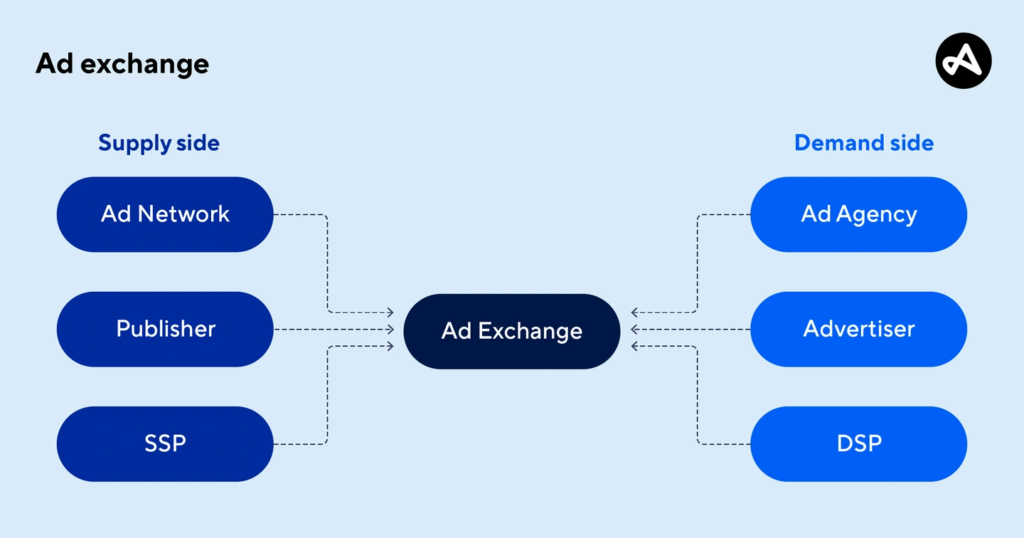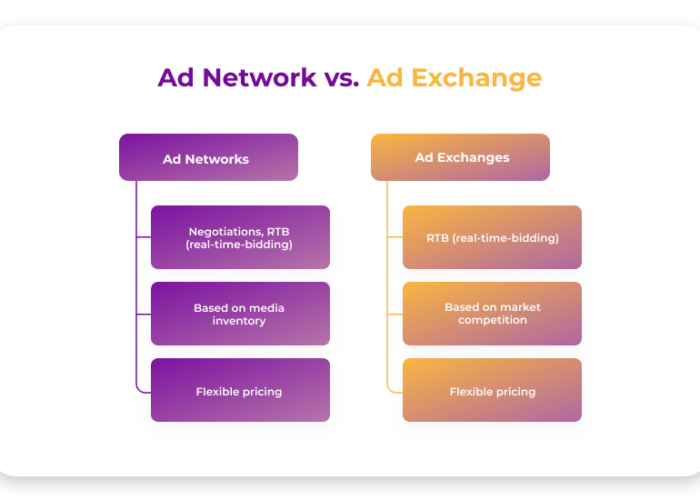Choosing the right advertising platform can be confusing. In the digital ad space, two major players dominate – Ad Networks and Ad Exchanges. This blog will clarify the difference between these platforms, ensuring you make an informed decision when opting for one over the other.
Ready to step into a simplified world of online advertising?.
Key Takeaways
- Ad networks act as intermediaries between advertisers and publishers, offering pre – segmented inventory and fixed pricing models.
- Ad exchanges are real-time auction-based platforms where publishers can sell ad impressions to advertisers through programmatic advertising known as real-time bidding (RTB).
- Advertisers must consider their specific goals and target audience when choosing between an ad network or ad exchange.
- For SaaS companies aiming to optimize their marketing spend, understanding the nuances of PPC for SaaS companies is crucial.
What is an Ad Network?
An ad network is a digital marketplace that connects online publishers with advertisers, allowing them to buy and sell ad space.

Definition and function
An ad network functions as an intermediary between advertisers and publishers, collecting unsold ad space from various publishers and offering it to advertisers. Ad networks categorize this inventory based on factors like demographics, location, and content niche.
Then they sell the categorized inventory to advertisers who want their ads shown to a specific audience. Similarly, an ad exchange is also a digital marketplace that facilitates buying and selling of online advertising spaces but with real-time bidding (RTB).
Publishers list their available ad space in this open marketplace – the exchange – wherein multiple advertisers bid for each impression individually in real time through automated auctions.
The highest bidder wins the right to display their advertisement on that particular site.
Inventory management and pricing
Ad networks play a vital role in inventory management and pricing. They act as intermediaries between online publishers, who have ad space available, and advertisers who are looking to place their ads.
Ad networks help manage the inventory by categorizing it based on factors such as website content, demographics, and user behavior. This segmentation allows advertisers to target specific audiences with their ads effectively.
Pricing in ad networks is typically determined through different models like cost-per-click (CPC) or cost-per-thousand impressions (CPM). Advertisers bid for the available inventory, and the highest bidder gets their advertisements placed on publisher websites.
What is an Ad Exchange?
An ad exchange is a digital marketplace that connects online publishers looking to sell their ad space with advertisers looking to buy and display ads.

Definition and function
An ad network is a digital marketplace that connects online publishers with advertisers. Its main function is to facilitate the buying and selling of ad space, allowing advertisers to reach their target audience and publishers to monetize their inventory.
Ad networks manage the pricing and placement of ads, often using different bidding models like cost-per-impression or cost-per-click. On the other hand, an ad exchange is a real-time auction-based platform where publishers can sell their ad impressions to advertisers through a programmatic advertising process known as real-time bidding (RTB).
Ad exchanges offer more transparency and control for both parties involved in the transaction.
Real-time bidding
Real-time bidding is a key feature of ad exchanges. It allows advertisers to bid in real-time for ad impressions as they become available. This means that advertisers can compete with each other to have their ads displayed on websites and apps in the exact moment that a user visits a page or opens an app.
Real-time bidding offers advertisers the opportunity to target specific audiences and only pay for the impressions that are valuable to them. It enables efficient advertising buying, as it eliminates the need for upfront negotiations and simplifies the process of purchasing ad inventory.
Key Differences Between Ad Network and Ad Exchange
Ad Network and Ad Exchange differ in terms of inventory pre-segmentation versus an open marketplace, pricing models, target users, campaign optimization, and audience segmentation.
Inventory pre-segmentation vs open marketplace
Ad networks and ad exchanges differ in their approaches to inventory management. Ad networks typically pre-segment their inventory by categorizing websites based on specific criteria like demographics or content type.
This allows advertisers to target their ads more precisely. On the other hand, ad exchanges operate as open marketplaces where publishers can list their ad space without any pre-segmentation.
Advertisers then have the freedom to bid on available impressions in real-time, giving them more control over where their ads are placed. The choice between inventory pre-segmentation and an open marketplace depends on the advertiser’s preference for targeting options and the level of control they desire over advertisement placement within the digital marketplace.
Pricing models
Ad networks and ad exchanges utilize different pricing models when it comes to buying and selling ad inventory. Ad networks typically use a fixed pricing model, where advertisers pay a predetermined rate for a set number of impressions or clicks.
This allows for more control over budgeting and campaign planning. On the other hand, ad exchanges use a real-time bidding (RTB) pricing model, where advertisers bid in real-time for each impression as it becomes available.
This dynamic auction-based system allows advertisers to pay based on the perceived value of each impression, resulting in potentially lower costs and higher efficiency.
Target users
Advertisers are the primary target users of both ad networks and ad exchanges. Advertisers seek to reach a specific audience with their ads, and both platforms offer different targeting options.
Ad networks typically focus on pre-segmenting inventory based on demographics or interests, allowing advertisers to easily choose where their ads will be displayed. On the other hand, ad exchanges provide an open marketplace where advertisers can bid in real-time for available impressions across a wide range of publisher inventory.
This gives advertisers more control and flexibility in reaching their desired audience. Ultimately, the choice between an ad network or an ad exchange depends on the advertiser’s specific goals and preferences.

Campaign optimization
To maximize the effectiveness of your advertising campaigns, it’s crucial to optimize them. This involves analyzing data and making adjustments to improve performance. By constantly monitoring key metrics such as click-through rates, conversion rates, and cost per acquisition, you can identify areas for improvement and make informed decisions to optimize your campaigns.
Adjusting ad placement, targeting options, bidding strategies, and creative elements are all part of campaign optimization. By continuously fine-tuning your campaigns based on real-time data insights, you can drive better results and achieve your marketing goals more effectively.
Campaign optimization is an ongoing process that requires careful analysis and experimentation. It allows advertisers to adapt their strategies in response to changing market conditions or customer behavior.
Audience segmentation
Advertisers and publishers both benefit from audience segmentation in the ad exchange and ad network platforms. By dividing their target audience into smaller, more specific groups based on demographics, interests, or behavior, they can tailor their advertising campaigns to reach the right people at the right time.
This allows advertisers to maximize their return on investment by ensuring that their ads are seen by individuals who are most likely to be interested in their products or services.
Similarly, publishers can use audience segmentation to offer targeted ad placements that command higher prices, increasing their revenue potential. Overall, audience segmentation is a crucial strategy for optimizing campaign performance and monetizing publisher inventory effectively in both ad exchanges and networks.
Which is Better: Ad Network or Ad Exchange?
Advertisers and publishers need to carefully consider their specific needs and goals in order to determine whether an ad network or ad exchange is the better choice for them.
Considerations for advertisers and publishers
Advertisers and publishers face important considerations when deciding between an ad network or an ad exchange. Advertisers need to evaluate their target audience and advertising goals to determine which platform will provide better access to the desired inventory and audience.
Ad networks offer pre-segmented inventory, allowing advertisers to reach specific demographics or interests. On the other hand, ad exchanges offer an open marketplace with real-time bidding, providing more flexibility and control over pricing and targeting options.
Publishers must consider how they want to monetize their ad space – through a fixed rate offered by an ad network or through auctions on an ad exchange. They should also take into account the level of control they want over their publisher inventory and impressions.
Choosing the right platform for your needs
To choose the right platform for your needs, you should consider several factors. Firstly, think about what your goals and objectives are as an advertiser or publisher. If you’re looking to target specific audiences and have more control over your campaigns, an ad network might be a better fit.
On the other hand, if you want access to a wide range of inventory in real-time through auctions, an ad exchange could be the way to go.
Additionally, take into account the targeting options offered by each platform. Ad networks often provide pre-segmented inventory that can help you reach your desired audience more effectively.
Ad exchanges, on the other hand, offer real-time bidding (RTB) opportunities where advertisers can bid for impressions based on their specific targeting criteria.
Conclusion
In conclusion, when considering whether to use an ad network or an ad exchange, it is important for advertisers and publishers to carefully evaluate their needs and goals. Ad networks offer pre-segmented inventory and pricing models that may be more suitable for specific targeting options.
On the other hand, ad exchanges provide access to a larger marketplace through real-time bidding and open auctions, offering more flexibility but also requiring more in-depth campaign optimization.
Ultimately, the choice between an ad network and an ad exchange depends on individual preferences and monetization strategies within the advertising ecosystem.
Frequently Asked Questions
1. What are the differences between an ad exchange and ad network?
An ad exchange is a realtime marketplace for buying and selling ads, while an Ad network collects inventory from multiple publishers and sells it to advertisers.
2. How does Realtime Bidding (RTB) work in ad exchanges?
Realtime Bidding is a feature of ad exchanges where display advertising spaces are bought and sold through a bidding process in real-time.
3. Is pricing different in an ad exchange compared to an Ad Network?
Yes, Ads on an exchange are typically priced in real-time, whereas on an Ad Network they can be pre-segmented or fixed price.
4. Can DSPs interact with both networks and exchanges?
Yes! A Demand Side Platform (DSP) interacts with both networks and exchanges, helping marketers manage their bids for the automated buying of online advertising.




